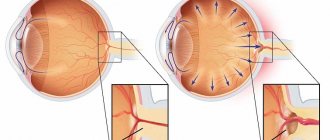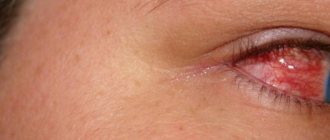When is sick leave given for conjunctivitis?
There are the following types of conjunctivitis, depending on the cause that caused it:
- bacterial;
- viral;
- fungal;
- allergic;
- mechanical.
The first two types of disease (bacterial, viral) are among the most contagious. The pathogen can spread through the following entry routes:
- airborne (sneezing, coughing, talking);
- tactile (handshake);
- household (through personal hygiene items, dishes).
If a sick person works with a large number of people, in public catering, the doctor will advise you to take sick leave.
Viral and bacterial forms of conjunctivitis are especially dangerous for children, the elderly, and sick patients. Their immune system does not function sufficiently, so the risk of infection increases.
If the disease appears in a child, a sick leave certificate is issued for one of the parents. But at the same time, the form of the disease is determined, and the child periodically visits the doctor. When the risk to his health has passed, he is not contagious, the sick leave ends.
The time required for sick leave depends on several factors:
- The disease must be acute, with pronounced symptoms. The patient's condition worsens.
- Form of the disease. For viral and bacterial conjunctivitis, sick leave is always given. If the patient has an allergic, fungal, mechanical type, a certificate of temporary incapacity for work is issued only if the patient’s well-being sharply deteriorates, which does not allow him to work normally.
Types and symptoms
The conjunctiva is a protective barrier for the organs of vision. It is the first to come into contact with external irritants, so the conjunctiva is equipped with local immunity that fights pathogenic microflora, preventing microorganisms from penetrating into the ocular structures. When the immune system is weakened or a large number of microbes attack the mucous membrane, an inflammatory process develops.
The disease mainly develops in adults who come into contact with a large number of people every day. People who use contact lenses face the problem of conjunctivitis. In this case, pathogenic microflora can penetrate the mucous membrane due to injury to the nails or fingers that occurs when the lenses are put on carelessly. Children who often rub their eyes with their hands are also susceptible to it.
The disease, both in adults and in children, has clearly defined symptoms that are so clearly manifested that it is simply impossible not to notice them.
The signs are as follows:
- The conjunctiva turns red and fills with blood.
- The eyelids become swollen.
- The eyes hurt when a person looks at the light; there is a burning sensation, a stinging sensation, or the presence of a foreign object.
This symptomatology is typical for all types of conjunctivitis. But there are also distinctive features.
- Bacterial. Caused by pathogenic microorganisms. The disease is characterized by purulent discharge of a yellowish or grayish color.
- Viral. In addition to “eye” symptoms, it is supplemented by cough, sore throat, and nasal discharge.
- Fungal. It is characterized by the presence of purulent discharge, the appearance of nodules on the conjunctiva, which, after opening, turn into difficult-to-heal fistulas.
- Allergic. A distinctive feature is unbearable itching and lacrimation. Symptoms may be supplemented by a skin rash and nasal congestion.
- Contact. It develops due to prolonged rubbing of the eyes with hands, or contact with a foreign object on the conjunctiva. Characterized by severe itching and pain.
Whether sick leave is given for conjunctivitis depends on how contagious it is.
How to get sick leave
If a person experiences symptoms of conjunctivitis, they should consult a doctor. After a complete examination of the patient, the doctor will suspect the disease, but its form can only be diagnosed using laboratory tests:
- Bacteriological culture. To do this, a smear from the patient's eye is inoculated on a nutrient medium. The growth of pathogenic microflora is detected within 5-7 days. Having identified the pathogen, the doctor determines the antibiotic to which it is sensitive. The study takes a long time, so the doctor most often determines the form of the disease based on clinical symptoms. The diagnosis of bacterial conjunctivitis is made if the patient has abundant discharge of pus from the eyes, the conjunctiva turns red, inflammation and swelling develop.
- PCR research. The technique is carried out quickly, within 1 day. To do this, a smear is taken from the patient's eyes, which is examined using a semi-automatic analyzer. It identifies the type of virus that caused the disease.
- Microscopy. The patient's smear is examined in several fields of view of the microscope. Detects bacteria, fungi and their spores.
A sick leave certificate is issued if a person is diagnosed with viral or bacterial conjunctivitis. Therefore, these studies are sufficient.
For an adult
An adult needs to see a therapist or ophthalmologist. If a person works with a large number of people, his activity involves public catering, doctors always issue sick leave to prevent the spread of the disease.
If an adult has an allergic, fungal, or mechanical type of illness, sick leave is given only if the patient’s well-being sharply deteriorates. This requires an increase in body temperature, inability to open the eyes, profuse swelling and inflammation.
To kid
If a child shows signs of inflammation of the conjunctiva, parents should consult a pediatrician or ophthalmologist.
They will examine the child's eyes and perform diagnostic tests. Most often, parents are always given sick leave, even if the baby has an allergic or fungal infection. This is due to the fact that if the child is not feeling well, he will not be able to attend kindergarten or school.
Signs of conjunctivitis
Conjunctivitis, diagnosed in children, is a common disease. The disease also affects the eyes of adults, and for conjunctivitis they are issued a sick leave if there are clearly expressed clinical signs. The disease is characterized by unambiguous, clearly defined symptoms:
- the whites of the eyes turn red;
- a foreign body is felt inside the eye;
- eyelids swell;
- the conjunctiva fills with blood;
- the patient often experiences itching and pain in the eyes;
- photophobia appears;
- in the morning it is impossible to open the eyelids due to dry discharge from the eyes.
Due to its clear symptoms, conjunctivitis is detected and diagnosed quickly. There is no point in delaying your visit to the doctor. The disease condition may progress. Some types of conjunctivitis are contagious, transmitted through airborne droplets or household contact. To obtain a sick leave certificate, a visit to an ophthalmologist or therapist is required. The doctor will definitely prescribe the necessary medications for treatment.
Duration of sick leave
The length of sick leave depends on the form of conjunctivitis. If it is bacterial, the doctor will advise you to take a temporary disability certificate for 10-14 days. With the viral form, the disease lasts longer. For example, for adenovirus, the minimum period of sick leave is two weeks, and for severe influenza conjunctivitis - 1 month.
Some sick people do not want to take sick leave when they get sick, as this will cause them to lose part of their salary. In this case, it is recommended to take a minimum period of rest during treatment in order to regain your strength and not spread the disease among people.
How many days does BL last on average for conjunctivitis and other diseases?
The total period of sick leave can vary from 3 days to a year . The employee is paid for all sick days for the year. When treating at home or when a patient visits a medical institution, the document is issued for up to 10 days. The newsletter can be extended by a doctor for a maximum of 15 days.
Longer periods are set by a special medical commission.
For most eye diseases, registration of the bulletin is indicated during the period of acute manifestation of the disease, during and after surgery. For example:
- The period of incapacity for work for an adult with barley takes on average from 3 days to a month, with conjunctivitis - from 3 days to 2 months.
- At the initial stage of eye cataracts with conservative treatment, a bulletin is not issued. For inpatient treatment, the document is issued for the entire period of stay in the hospital. The time spent on the ballot after cataract surgery is a minimum of 10 days. If long-term recovery is required, the period can be extended to a year.
- In case of eye burns , for example, from welding, the period of incapacity for work depends on the degree of damage. For a first-degree burn, sick leave lasts 7 days, a second-degree burn lasts 3-4 weeks, a third-degree burn lasts 4-6 weeks, and a fourth-degree burn requires disability.
Is it possible to feign illness in order to receive a certificate of incapacity for work?
You can simulate the disease by causing artificial conjunctivitis. Another question is, is it worth risking the health of your eyes, which cannot be replaced by anything, for the sake of a few days of sick leave? An experienced ophthalmologist can easily identify deliberate simulation:
- the damage has a clear boundary and precise localization;
- conflicting medical history;
- the presence of foreign inclusions and uncharacteristic color spots;
- negative bacterial culture indicators;
- absence of accompanying symptoms.
Useful video
Viral conjunctivitis:
Signs of the disease
The manifestation of inflammation directly depends on the form of the lesion and the type of conjunctivitis. However, there are main signs that are characteristic of all types of pathology.
Among them:
- swelling;
- increased blood filling of blood vessels;
- discharge of pus;
- feeling of “sand” in the eyes;
- pain, burning of the organs of vision;
- increased lacrimation;
- photosensitivity.
A characteristic symptom of the disease, by which the type of conjunctivitis is usually recognized, is “clinging”: in the morning it is difficult to open the eyes, it seems as if they are glued together. A slight or obvious decrease in vision, depending on the type of etiology, is possible.
Usually, conjunctivitis involves damage to both eyes; it does not always go away at the same time; the symptoms and the degree of impact of the damaging factor on the mucous membrane may differ.
A feature of the development of bacterial conjunctivitis is specific purulent discharge. They resemble a viscous liquid of a yellowish or greenish color. Dry eyes and skin and pain are observed.
When a viral type of disease occurs, the source of infection is respiratory tract infections. The patient complains of increased lacrimation, fear of light, and slight purulent discharge from the mucous membrane. There are some types of viral conjunctivitis: follicular and membranous - follicles or pseudomembranes form on the eye.
Symptoms of the allergic type are characterized by severe itching in the eyes, it is painful to touch them, there is increased lacrimation and swelling.
Other signs are possible depending on the typology of the allergy.
The manifestations of fungal conjunctivitis depend on the type of fungus.
Thus, actinomycosis provokes the development of the disease with the release of a large amount of purulent fluid; the mucus in blastomycosis is more reminiscent of a gray filmy fluid. The fungus candidiasis leads to the appearance of characteristic nodules, and aspergillosis affects the cornea.
If conjunctivitis occurs against the background of negative environmental influences, chemical or mechanical, a person experiences pain when blinking and moving the eyes. A typical example is dust or small particles getting into the eyes.
Features of each type of conjunctival inflammation
Existing factors that cause inflammation make it possible to classify the disease into types:
- Bacterial conjunctivitis. The disease occurs due to infection of the eyes by bacterial flora. Regardless of the microorganisms that provoked the inflammatory process, cloudy, viscous purulent compartments appear. They have a grayish, sometimes yellowish color, and gather near the eyelashes. Pus may be a consequence of other pathologies, for example, diseases of the ENT organs, simultaneously occurring in the body.
- Viral type. It manifests itself when various viruses enter the body and cause concomitant colds. Simultaneously with conjunctivitis, nasal discharge (snot), sore throat, and cough appear. An increase in body temperature may occur. A child develops a viral type of pathology relatively rarely.
- Conjunctivitis of fungal etiology occurs due to various fungi; a characteristic purulent discharge appears in the eyes. The disease occurs in subacute or chronic form. Ophthalmomycosis is characterized by slow progression of the disease. Nodules form on the conjunctiva, opening after some time, and instead of them, fistulas that do not heal for a long time appear.
- Chlamydial type. The “culprits” for the development of pathology are bacteria – chlamydia. They can be transmitted by contact.
- Exposure to various allergens provokes the manifestation of an allergic type of disease. With this inflammation, discharge does not appear from the eyes. However, due to the unbearable itching and pain, tears flow. The manifestation of symptoms persists until the factor that caused the inflammation is completely eliminated.
- Contact conjunctivitis occurs due to exposure to traumatic factors of a physical or chemical nature on the organs of vision - dust getting into the organs of vision, sitting near a fire, prolonged crying of a child, accompanied by rubbing the eyes with dirty hands.
In case of unbearable burning in the eyes, fever, or some other cases, due to particularly severe symptoms, the child, and sometimes an adult, is prescribed to go to the hospital. In this case, sick leave for conjunctivitis will be given.
What to do if the doctor refuses to issue a certificate of incapacity for work?
A doctor may refuse to issue a sick leave certificate for a number of reasons. You need to act based on the specific situation:
- sick leave is not issued for one day, so when visiting a doctor, the employee receives a certificate of the fact of the visit indicating the diagnosis;
- sick leave is not issued if there are no indications for release from work. If you disagree with the doctor’s opinion, a person has the right to contact another doctor or a senior manager of the institution (manager, chief physician);
- If you are denied again, you should contact the insurance company.











